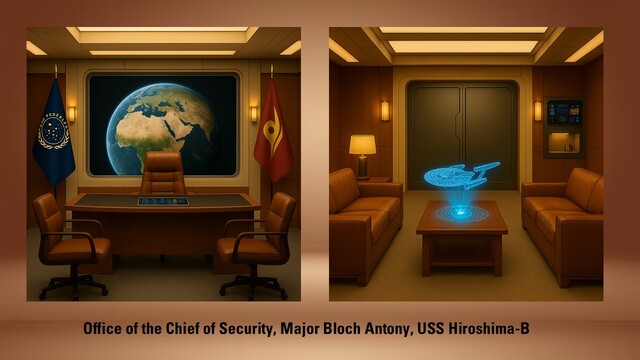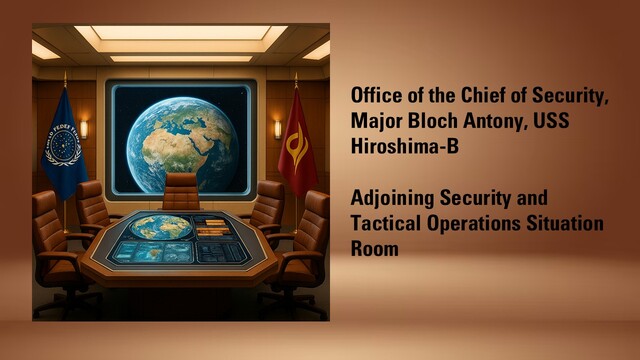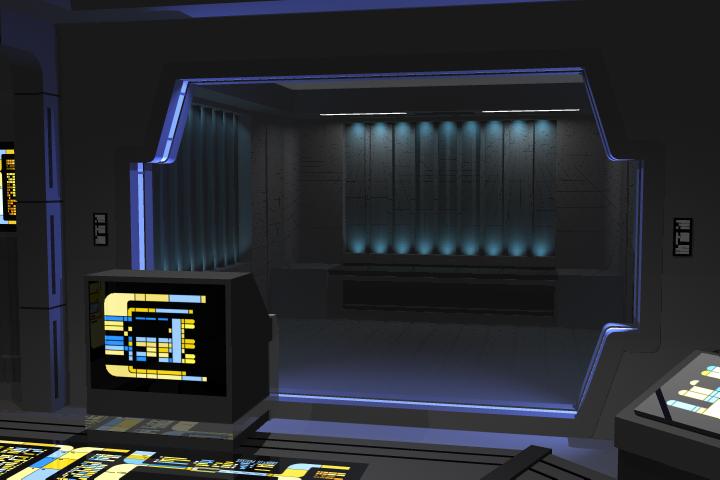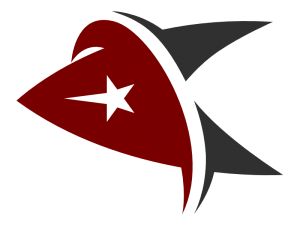Security and Tactical Department is responsible for the physical security of the ship, as well as the employment of all weapon systems. As such, they own and maintain the ship’s phaser arrays, torpedo launchers and shield generators, working closely with Engineering Department to keep these systems at maximum readiness.
Security: The main role of security forces is to prevent any crimes from occurring. Failing this, patrols are ready to take matters in hand. Normally, only phaser-II weapons are carried. Under higher-threat conditions, the phaser-III rifle is utilized. Prisoner internment facilities are provided in the ship’s brig. The cells specially modified to safely contain most known species, from small animals to Gorn.



Weapon Systems:
Phasers: The phaser is the standard Federation beam weapon system. This type of weapon came into common use c.2255, replacing the laser weapons then in service. Phaser is an acronym for PHASed Energy Rectification, a term which referred to the original process by which stored or supplied energy was converted to another form for release toward the target without any need for an intermediate energy transformation. Although this term is something of a holdover, it remains true in modern phaser systems. Phaser energy is released by the rapid nadion effect. Rapid nadions are short-lived subatomic particles which can liberate and transfer strong nuclear forces within a class of crystals called fushigi-no-umi.
Type XII Phasers: As of 2394 this was the heaviest weapon in use aboard the most sophisticated, but experimental, Federation vessels, comprising the main armament of the Vesta Class starship.
Torpedoes: The Quantum Torpedo is Starfleet’s most powerful torpedo-type weapon and has seen an extensive roll-out over the past 20 years. Unlike the matter/anti-matter explosive of a photon torpedo, a quantum torpedo relies on rapid energy extraction from a zero-point vacuum using an 11-dimensional space-time membrane twisted into a string-like structure. This membrane is expanded through the detonation of a plasma torpedo warhead, forming subatomic particles and a high-energy explosion.
The Photon Torpedo is a powerful, long range weapon which has been in use aboard Federation Starships for over one hundred and fifty years – early models differed from today’s weapon only in the level of sophistication and the power of the warhead. Today the weapon most widely used by Starfleet vessels is the Type 6. This weapon comprises an elongated elliptical body some 210 cm long and 76 x 45 cm across. The torpedo masses 247.5 kilos when not loaded.
The warhead of the photon torpedo comprises a maximum of 1.5 kilos of antimatter and 1.5 kilos of matter. These are divided into many thousands of small pellets suspended in a magnetic field – smaller yields can be achieved by reducing the number of such pellets in the torpedo.
Also included in the torpedo are target acquisition, guidance and detonation assemblies and a warp sustainer unit. The latter is charged by the launching vessels own drivefield at launch, boosting the torpedo speed up to Vmax = Vl + (0.75 Vl / c), where Vl is the velocity of the launching vessel. If launched at low impulse flight the torpedo will accelerate to a 75% higher sublight velocity; launch at high impulse speed will not push the torpedo into warp. If launched during warp flight the torpedo will continue at warp until the sustainer is exhausted. Torpedo range can be extended by utilizing the matter / antimatter warhead to power the sustainer, although this causes a corresponding loss of warhead yield. For a mid-range yield the torpedo can achieve ranges of some 3,500,000 kilometres at sublight speeds.
The photon torpedo can be set to fly a ballistic trajectory, be steered by the launch vessel, can home in via its own guidance systems, or use a combination of these methods in a single flight.
The warhead of a photon torpedo can be removed and replaced by sensor packages or other equipment. Some advanced models are fitted with full warp drives for use as long range high speed probes – the Class VIII probe can cover 1.12 light years at Warp 9, while the Class IX probe can cover 2 light years at the same speed. On one occasion such a device was used to transport a Federation diplomat to an urgent rendezvous.
